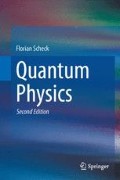Abstract
This chapter deals with the quantum theory of systems with an infinite number of degrees of freedom and provides elements of quantum field theory.
Access this chapter
Tax calculation will be finalised at checkout
Purchases are for personal use only
Notes
- 1.
After H. Yukawa who in 1936 predicted the existence of \(\pi \)-mesons from an interpretation of nuclear forces by the exchange of mesons, and from the range of these forces.
- 2.
As the fields decrease sufficiently fast at infinity there is no loss of generality in assuming \(\varSigma \) to approach \(\varSigma _0\) smoothly at spatial infinity.
- 3.
It would seem unfortunate to talk about “positive energy term” because then its adjoint would refer to negative energies, instead of negative frequencies. Free particles (or antiparticles) with mass \(m\) always have positive energy.
- 4.
Strictly speaking, the integrals that one is dealing with are tempered distributions. However, all definitions for tempered distributions are chosen such that formal calculus follows the same rules as the calculus with functions and genuine integrals. This remark shows that the derivation of (7.60) as given here is correct.
- 5.
The term “gauging” is used here in a figurative sense but alludes to genuine gauging, or rescaling, of a (real) metric, \(g_{\mu \nu } (x)\mapsto g^{\prime }(x)=\exp \{\lambda (x)\}g_{\mu \nu } (x)\). In fact, this was the context within which Hermann Weyl invented the notion of gauge transformation in 1919.
- 6.
Turning one’s head to the right, and barring too much artistic scrutiny, one will recognize a seagull in Fig. 7.7.
- 7.
Note that we had chosen the convention \(\varepsilon \) \(_{\scriptscriptstyle 0123}=+1\).
- 8.
This condition was first found by Ludvig Valentin Lorenz (1829–1891), a Danish physicist, long before Hendrik Antoon Lorentz’ times to whom this relation is often but erroneously attributed.
- 9.
In the case of Einstein’s equations for the gravitation field the analogous analysis shows that the graviton is massless and has spin/helicity 2.
- 10.
The transition (\(\mathrm{{2s}}\rightarrow \mathrm{{1s}}\)) is possible through emission of two photons, or through a small relativistic term, unless it is induced by collisions with other atoms.
- 11.
This is a detailed calculation which becomes more systematic by Wick’s theorem, cf. Theorem 5.1.
- 12.
Presumably, no one would be tempted to treat the radiation emitted by an FM-radio station in the framework of quantum electrodynamics. As one easily estimates, the number of emitted photons per unit of volume is many orders of magnitude and, hence, very large as compared to \(1\).
- 13.
A notable exception where this correction cannot be neglected are precision measurements by means of high-frequency spectroscopy. Such measurements are done in view of detecting radiative corrections as predicted by quantum electrodynamics. They are sensitive to even very small effects.
- 14.
- 15.
F. Strocchi, Phys. Rev. 162 (1967) 1429.
- 16.
The ansatz \(D_1=c\;\square _q\delta ^{(4)}(q)\) is excluded as well. To see this calculate \(\int \mathrm{{d}}^4q\; (q^{\mu } q^{\nu } -q^2g^{\mu \nu } )D_1g(q) \propto g(0)\), which may be different from zero – in contradiction with the conclusion reached above.
- 17.
It is not obvious that the commutator is indeed a \(c\)-number. This needs a detailed proof.
Author information
Authors and Affiliations
Corresponding author
Rights and permissions
Copyright information
© 2013 Springer-Verlag Berlin Heidelberg
About this chapter
Cite this chapter
Scheck, F. (2013). Quantized Fields and Their Interpretation. In: Quantum Physics. Springer, Berlin, Heidelberg. https://doi.org/10.1007/978-3-642-34563-0_7
Download citation
DOI: https://doi.org/10.1007/978-3-642-34563-0_7
Published:
Publisher Name: Springer, Berlin, Heidelberg
Print ISBN: 978-3-642-34562-3
Online ISBN: 978-3-642-34563-0
eBook Packages: Physics and AstronomyPhysics and Astronomy (R0)

